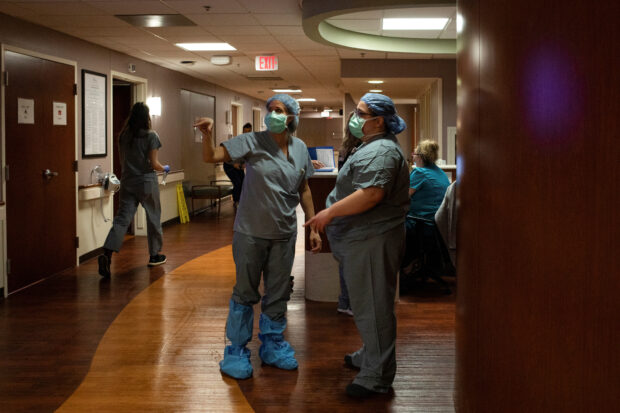Strong services price hikes lifted US producer inflation in Jan

A doctor and nurse consult in the hallway as a patient prepares to be transferred for an emergency C-section in the Family Birth Center at Beaumont Hospital in Royal Oak, Michigan, U.S., Feb 1, 2022. REUTERS/Emily Elconin/File photo
WASHINGTON —U.S. producer prices increased more than expected in January amid strong gains in the costs of services such as hospital outpatient care and portfolio management, stoking financial market fears inflation was picking up after months of cooling.
The increase reported by the Labor Department on Friday was the largest in five months. The report followed on the heels of an above-expectations rise in consumer prices in January and prompted financial markets to dial back expectations that the Federal Reserve would start cutting interest rates in June.
Data on Thursday also showed prices of imported goods surging in January. But some economists cautioned against concluding that inflation was re-accelerating noting that businesses typically raise prices at the start of the year. These price hikes probably were larger this year as businesses tried to make up for higher labor costs in the past year.
READ: Rents boost US consumer prices in Jan
Economists also suspected that the model used by the government to strip out seasonal fluctuations from the data could be falling short. Nevertheless, the reports this week raised the risk of higher readings in the personal consumption expenditures (PCE) price indexes, the measures tracked by the U.S. central bank for its 2 percent inflation target, when the government publishes January’s data later this month.
“The Fed isn’t losing the inflation fight, but they aren’t winning either,” said Christopher Rupkey, chief economist at FWDBONDS in New York. “The data are consistent, that January is a problem month for inflation. There could be some seasonal adjustment problems as prices move up the most each year in the dead of winter.”
The producer price index for final demand rose 0.3 percent last month, the largest increase since August 2023, after declining by a revised 0.1 percent in December, the Labor Department’s Bureau of Labor Statistics said. Economists polled by Reuters had forecast the PPI gaining 0.1 percent following a previously reported 0.2 percent drop.
In the 12 months through January, the PPI increased 0.9 percent after climbing 1 percent in December.
Services increased 0.6 percent, the largest rise since July 2023, boosted by a 2.2-percent jump in hospital outpatient care. The surge in these costs was attributed to strong wage increases over the past year. Portfolio management fees surged 5.5 percent, likely driven by higher stock market prices.
There were also increases in wholesale prices of hotel and motel rooms as well as legal services. But the cost of transporting freight by road decreased 1 percent. Services, at the core of the fight against inflation, dropped 0.1 percent in December.
“We would not dismiss strength in January services prices as a one-off phenomenon,” said Veronica Clark, an economist at Citigroup in New York. “This upward pressure can continue, especially for sectors like medical services that still face tight labor markets.”
Wholesale goods prices fell 0.2 percent, declining for the fourth straight month. Food prices dropped 0.3 percent, while the cost of energy plummeted 1.7 percent.
Excluding food and energy, goods prices rose 0.3 percent. The so-called core goods prices gained 0.1 percent in December.
Portfolio management fees, healthcare, hotel and motel accommodation, and airline fares are among components that go into the calculation of the PCE price indexes.
Based on the CPI and PPI data, economists estimated the PCE price index excluding food and energy increased 0.4 percent in January, with the risk of rounding up to 0.5 percent. The core PCE price index climbed 0.2 percent in December.
In the 12 months through January, core inflation was forecast increasing 2.9 percent, matching December’s advance.
Stocks on Wall Street were trading lower. The dollar was steady versus a basket of currencies. U.S. Treasury prices fell.
Housing starts fall
Financial markets still expect the Fed to deliver its first rate cut this year, though the odds of a move in June are diminishing. Since March 2022, the Fed has raised its policy rate by 525 basis points to the current 5.25 percent-5.5 percent range.
The narrower measure of PPI, which strips out food, energy and trade services components, jumped 0.6 percent in January. That was the biggest increase in a year a followed a 0.2-percent gain in December. The core PPI rose 2.6 percent on a year-on-year basis, matching December’s gain.
The spate of disappointing January data extended to the housing market. A separate report from the Commerce Department showed single-family homebuilding fell last month, likely because of harsh weather, but a rise in permits for future construction suggested a rebound in the coming months.
Single-family housing starts, which account for the bulk of homebuilding, dropped 4.7 percent to a seasonally adjusted annual rate of 1.004 million units last month, the Commerce Department’s Census Bureau said. Homebuilding remains supported by an acute shortage of previously owned houses on the market.
Extremely cold weather across much of the country during the month likely made it difficult to break ground on new projects. The below-normal temperatures helped to depress retail sales and manufacturing production in January.
Permits for future construction of single-family homes increased 1.6 percent to a pace of 1.015 million units, the highest level in nearly two years. They have increased for 12 straight months. Starts for housing projects with five units or more plunged 35.8 percent to a rate of 314,000 units in January.
Multi-family building permits dropped 9 percent to a rate of 405,000 units last month. There remains a huge backlog of multi-family housing under construction.
“Clearly, builders are currently far more focused on filling the gap left by the shortage of single-family housing than they are on building apartments,” said Daniel Vielhaber, an economist at Nationwide in Columbus, Ohio.